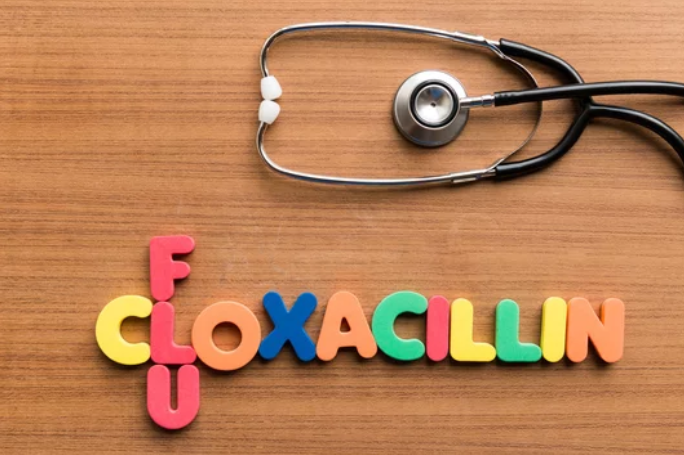Everything You Need to Know About Flucloxacillin



Flucloxacillin is a penicillin-class antibiotic that’s prescribed to treat bacterial infections. It’s used to treat:
Otitis media (ear infections) in children ages six months and older
Pneumonia caused by Streptococcus pneumoniae or Haemophilus influenzae type B (Hib)
Staphylococcus aureus-caused skin and soft-tissue infections that are not complex, S. pyogenes, or group A Streptococcus
Acute bacterial sinusitis (infection of the sinuses)
Strep throats or sore throats
Acute bacterial exacerbation of chronic bronchitis
Acute pyelonephritis (kidney infection)
Other conditions like bone infections (osteomyelitis) and urinary tract infections
Flucloxacillin can also treat patients with a history of penicillin allergies or sensitivity. You may consult your healthcare provider about whether flucloxacillin is right for you, how long it would be safe to take it, and what side effects might come up along the way!
Flucloxacillin belongs to antibiotics called penicillins that fight harmful bacteria in your body by disrupting their cell walls. It’s used to treat infections caused by staphylococci and streptococci, common types of bacteria found in the nose, throat and skin.
Flucloxacillin stops bacteria from multiplying by attacking the bacterial cell walls and damaging the bacteria’s genetic material, thereby preventing them from forming. It allows your immune system to destroy them more quickly, helps your body fight back against the infection, and prevents it from getting worse. It also prevents bacteria from sticking to surfaces, tissues, cells or each other.
Flucloxacillin is also used to treat infections caused by E. coli, a type of bacteria found in the colon and intestines that can spread through food or water that hasn’t been properly cooked or cleaned before consumption. It can also fight infections caused by certain fungi types, such as Candida albicans.
Flucloxacillin is suitable for most people, including pregnant and breastfeeding women. You can use it during lactation without any problems being passed on to the child. The medicine is prescribed for people at high risk of getting an infection caused by a particular type of bacteria. It includes people with previous infections from the same bacteria, such as streptococcus or staphylococcus. You may also use it to treat certain infections that can’t be treated with other antibiotics.
In addition, flucloxacillin is recommended for people with a weakened immune system, such as those who have an organ transplant or receive chemotherapy. It’s also recommended for people taking other medications that suppress their immune system and make them more susceptible to infection.
Flucloxacillin is a prescription medication that’s available in tablet form. It’s taken by mouth and should be swallowed with a full glass of water. If you can’t swallow the pill whole, it can be crushed and mixed with food or applesauce to make it easier to swallow.
Before you take flucloxacillin, tell your doctor if:
You are allergic to flucloxacillin or any of its other ingredients.
You are allergic to cephalosporins, or you have a penicillin allergy or allergy to the aminopenicillin group of antibiotics.
You have a history of kidney problems (such as kidney failures), liver problems or intestinal disorders, such as colitis. Taking this medicine while having ulcerative colitis (an inflammatory bowel disease) might worsen your symptoms.
You have a history of seizures or strokes.
You are pregnant or breastfeeding, as this medication can harm your child.
You have a fungal infection (e.g., athlete’s foot).

Flucloxacillin can interact with other drugs. Some medicines may affect how flucloxacillin works, or flucloxacillin may affect how your other medicines work. Make sure your doctor or pharmacist knows about all your medicines and supplements, including prescription, over-the-counter and herbal medications, vitamins or minerals.
It would be best not to take flucloxacillin with other medicines containing clavulanic acid. These include Augmentin and Cotrim (trimethoprim and sulfamethoxazole).
Taking flucloxacillin while taking other antibiotics or antifungal medications is not recommended.
Medicines that you can take with flucloxacillin include:
Antacids, like Mylanta or Rolaids, and certain pain relievers that do not contain aluminium or magnesium
Cholestyramine (Questran) and colestipol (Colestid) are used to lower cholesterol and prevent gallstones
Digoxin (Lanoxin), which is used to treat an irregular heartbeat
calcium supplements (such as Tums)
laxatives
proton pump inhibitors like lansoprazole (Prevacid)
bismuth subsalicylate (Pepto-Bismol)
cimetidine (Tagamet)
cephalosporins (e.g., cefadroxil, cephalexin, cefuroxime)
metronidazole
doxycycline, minocycline and tetracycline (antibiotics)
quinolone antibiotics, such as ciprofloxacin and norfloxacin
Flucloxacillin can be taken with or without food. Always remember to take your medication at the same time each day, ideally first thing in the morning or last thing at night.
Children over the age of 12 are usually given flucloxacillin. The dosage will depend on their weight and age. Children under 18 should not take flucloxacillin unless they have a bacterial infection or strep throat that has not responded to other types of treatments.
The use of flucloxacillin can lead to several side effects, including stomach cramps and diarrhoea. If you want to continue taking this medicine for an extended period, be sure to contact your doctor if symptoms such as these occur. Other possible side effects include:
Nausea and vomiting
Loss of appetite
Headache
Some of these side effects are more likely to occur if you have kidney problems.
Flucloxacillin may cause serious side effects, such as allergic reactions and liver toxicity/damage. However, these reactions are infrequent (<0.1%).
Flucloxacillin can cause several different side effects. Listed below are a few of the most often experienced adverse effects:
Kidney problems. Flucloxacillin can lower blood potassium levels, which can cause kidney damage and other severe health conditions.
Liver problems. Long-term use of flucloxacillin may lead to liver damage and increase your risk of developing liver disease.
Allergic reactions (skin rash, hives). Suppose you have an allergy to penicillin or cephalosporins. In that case, you’re more likely to be allergic to flucloxacillin than other types of antibiotics as well. Symptoms include a rash on your face or body, hives and itching around the mouth area or eyes (called angioedema). You should get medical assistance right away for any signs of an allergic reaction while taking this medication -- which includes:
swelling around your lips, tongue or throat that results in difficulty breathing
vomiting
abdominal cramps
dizziness
fainting spells
Flucloxacillin is a reasonably safe antibiotic, but there are still things you should know about when taking it.
Flucloxacillin is a penicillin antibiotic used to treat many bacterial infections. It’s available as capsules, tablets and syrup and can be taken with or without food.
It is similar to other penicillin drugs (like amoxicillin) in that it disrupts the production of proteins needed for bacteria to grow and reproduce. But unlike some antibiotics that are absorbed slowly into the bloodstream—and thus require you to take them multiple times per day, your body quickly absorbs flucloxacillin in its entirety through your stomach lining and small intestine. It means that only one daily dose is necessary to keep your infection at bay.
An extra dose of flucloxacillin is not recommended. However, if you have taken the whole course of the antibiotic and your infection is still present, this may be due to a resistant strain of bacteria. In this case, your doctor may prescribe an alternative form of treatment.
To ensure the drug is absorbed as well as possible, flucloxacillin must be taken with an empty stomach. Taking it with food can decrease the flucloxacillin absorbed into your bloodstream, which may make it less effective at fighting your infection. If you forgot to take flucloxacillin or missed dose, do not take two doses at once! The following normal dose should be taken as soon as you remember but at least 12 hours after the last dose. If it is less than six hours since your previous dose, wait until the normal next one before taking two doses together.
Flucloxacillin is an excellent antibiotic to have on hand if you need it. It’s safe, effective, and easy to take. It offers a fast-acting and reliable treatment for most bacterial infections, including strep throat, tonsillitis, ear infections, and skin rashes. If you’re considering this drug as part of your treatment plan or want more information about how it works, remember that it’s best to talk with health professionals about any questions or concerns before starting any new medicine.
Learn about more medications for skin concerns. Read about OTC medications for common skin problems and what is betnovate cream used for.










Plus get the inside scoop on our latest content and updates in our monthly newsletter.